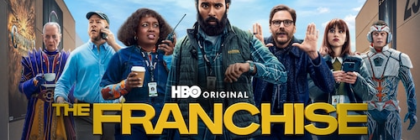
Health Screeners: Documenting Medical Issues through Digital Media
Guillermina Zabala Suárez / University of Texas at San Antonio
Guillermina Zabala Suárez asks: Can digital media become a device to create awareness of health issues in out communities?
Read moreSurviving Dystopia: Immersive Spectacle as Transmedia Marketing in Netflix’s K-dramas
Hyun Jung Stephany Noh / Texas A&M Corpus Christi
Hyun Jung Stephany Noh analyzes the immersive and interactive spectacles Netflix employs as transmedia marketing strategy for its “K-dystopian” dramas, an emerging post-Covid genre.
Read more“Just let people be!”: The Assembly, inclusivity, and aspirational feeling
Helen Piper / University of Bristol
Helen Piper explores how the format and presentation of The Assembly UK encourages feelings of community and acceptance.
Read moreThe Necessity of Politicized Hybridization in the Local Cultural Industries
Dal Yong Jin / Simon Fraser University
Dal Yong Jin discusses cultural hybridization in the global media era with a special look at the Netflix phenom “K-Pop Demon Hunters.”
Read moreHow Art Entered the Screen Age
Anna Lovatt / Southern Methodist University
Dr. Anne Lovatt takes a closer look at contemporary artists whose work critically engages with televisuality and screen age.
Read moreRobotic Slaves and Where to Find Them: Racial(ized) Servitude in The Jetsons
Golden M. Owens / University of Washington
Owens argues that Rosey the Robot from The Jetsons demonstrates the connection between service technologies and Black housemaid archetypes, lending to considerations of how technologies can contain and disseminate harmful ideologies.
Read moreNouveau-riche Nationalism and the Politics of Prejudice: A Case from South Korea
Gil-Soo Han / Monash University
This column highlights the sacrifice and contribution of South Korean miners and nurses in the mid-20th century that greatly impacted the country’s industrialization. Now, the roles have reversed, as the country “depends on foreign workers to staff industries that native Koreans avoid.” Gil-Soo Han elaborates on this difficult idea with his term “nouveau-riche nationalism;” Han gives examples of discrimination against migrant laborers, human rights violations in the Korean workforce, and public attitudes surrounding these issues. How can South Korea shape its national identity into one that carves a path to a truly inclusive future?
Read moreCAN FANDOM SAVE THE SUPERHERO FILM? THE FANBOY AUTEUR IN HBO’S THE FRANCHISE
Laurel P. Rogers / University of Texas at Austin
Laurel Rogers looks at the role of the “fanboy auteur” in HBO’s backstage comedy The Franchise, which satirizes the superhero industrial complex.
Read moreCamera Looks, Laugh Tracks, and TV Comedy
Michael Z. Newman / University of Wisconsin-Milwaukee
Dr. Newman explores how the use of camera looks in sitcoms like Abbott Elementary serves as a comedic device that establishes a direct connection with the audience, blending old and new traditions of comedic performance to invite viewer participation and emotional response.
Read moreAdvertising, AI, and the Political Economy of Media and Communications
Matthew Crain / Miami University
Matthew Crain argues that advertising’s integration into AI-driven media technologies, such as Perplexity’s AI search engine, is not driven by natural market tendencies. Instead, it results from systemic commodification and political-economic forces, as analyzed through the Political Economy of Media and Communications (PEMC) framework.
Read more Silicon Valley’s Human Shields
Gerald Sim / Florida Atlantic University
Gerald Sim critiques Big Tech’s lobbying strategies against antitrust legislation, arguing that companies use technoliberal narratives, racialized imagery, and nationalist rhetoric, such as the “China Argument,” to manipulate public opinion, obscure exploitative labor practices, and maintain dominance.
Read moreFair Payment in the Film and Television Industries
Roderik Smits / Erasmus University Rotterdam
Dr. Roderik Smits explores various factors affecting what constitutes “fair pay” in the film and television industries.
Read more















